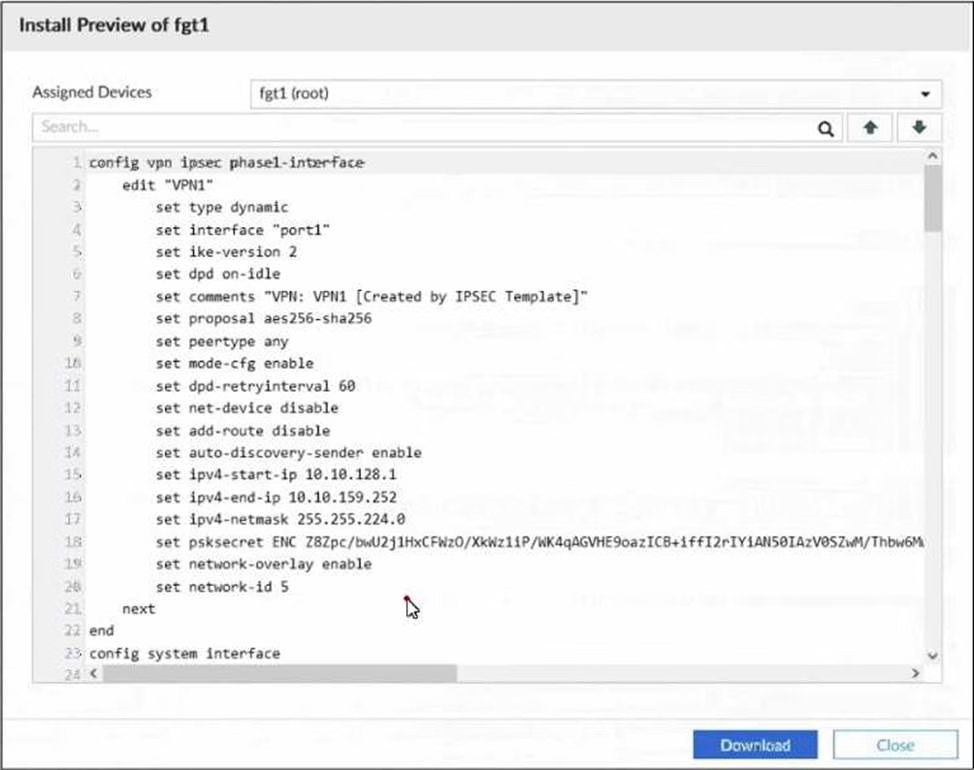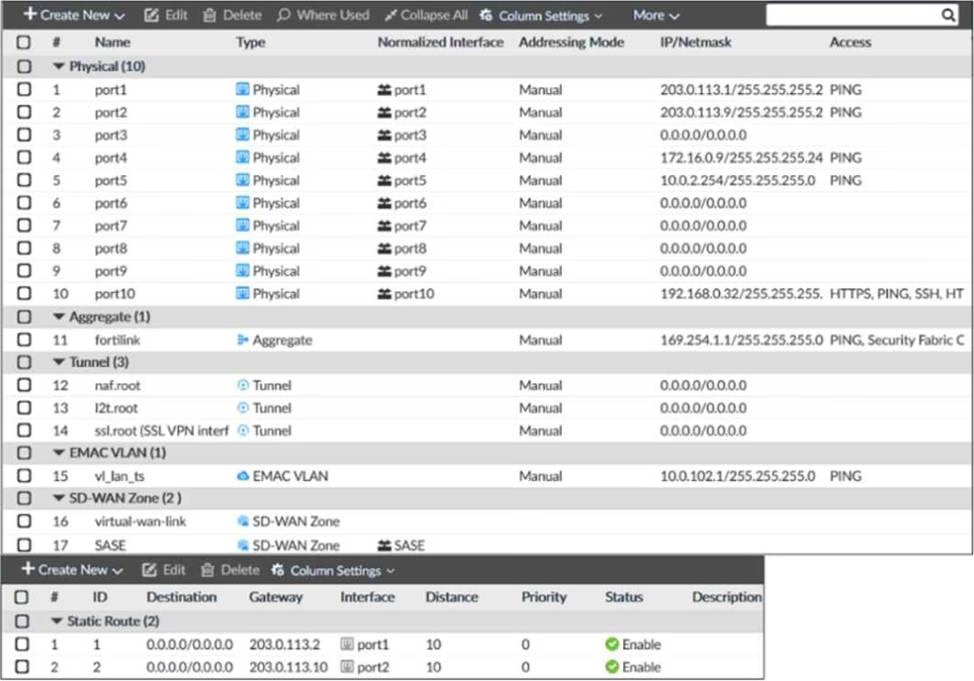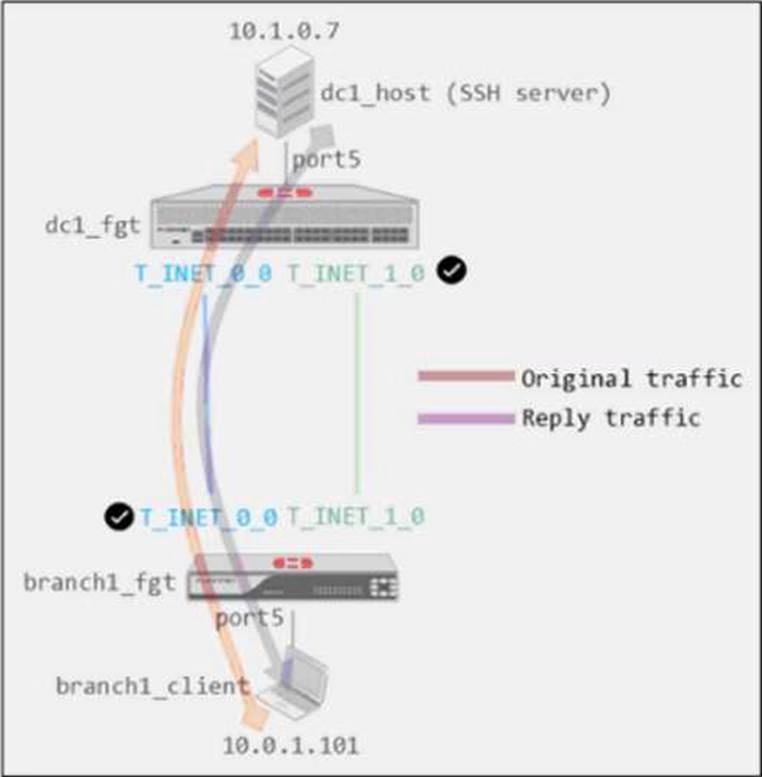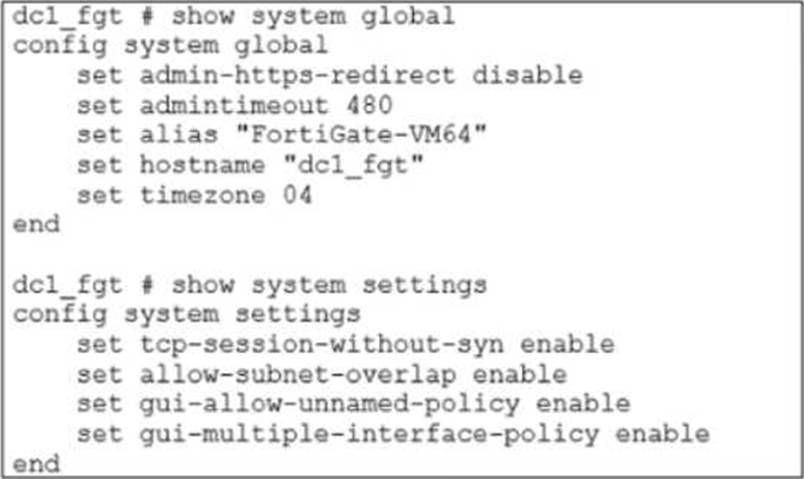Fortinet NSE7_SDW-7.2 Fortinet NSE 7 – SD-WAN 7.2 Online Training
Fortinet NSE7_SDW-7.2 Online Training
The questions for NSE7_SDW-7.2 were last updated at Dec 16,2025.
- Exam Code: NSE7_SDW-7.2
- Exam Name: Fortinet NSE 7 - SD-WAN 7.2
- Certification Provider: Fortinet
- Latest update: Dec 16,2025
What are two advantages of using an IPsec recommended template to configure an IPsec tunnel in a hub-and-spoke topology? (Choose two.)
- A . VPN monitor tool provides additional statistics for tunnels defined with an IPsec recommended template.
- B . FortiManager automatically installs IPsec tunnels to every spoke when they are added to the FortiManager ADOM.
- C . IPsec recommended template guides the administrator to use Fortinet recommended settings.
- D . IPsec recommended template ensures consistent settings between phase1 and phase2
Refer to the exhibit.

An administrator used the SD-WAN overlay template to prepare an IPsec configuration for a hub-and-spoke SD-WAN topology. The exhibit shows the installation preview for one FortiGate device.
In the exhibit, which statement best describes the configuration applied to the FortiGate device?
- A . It is a hub device. It can send ADVPN shortcut offers.
- B . It is a spoke device that establishes dynamic IPsec tunnels to the hub. The subnet range is 10.10.128.0/23.
- C . It is a spoke device that establishes dynamic IPsec tunnels to the hub. It can send ADVPN shortcut requests.
- D . It is a hub device and will automatically discover the spoke devices that are in the SD-WAN topology.
Which three matching traffic criteria are available in SD-WAN rules? (Choose three.)
- A . Type of physical link connection
- B . Internet service database (ISDB) address object
- C . Source and destination IP address
- D . URL categories
- E . Application signatures
Which two interfaces are considered overlay links? (Choose two.)
- A . LAG
- B . IPsec
- C . Physical
- D . GRE
Refer to the exhibit.

Exhibit B

Exhibit A shows the system interface with the static routes and exhibit B shows the firewall policies on the managed FortiGate.
Based on the FortiGate configuration shown in the exhibits, what issue might you encounter when creating an SD-WAN zone for port1 and port2?
- A . port1 is assigned a manual IP address.
- B . port1 is referenced in a firewall policy.
- C . port2 is referenced in a static route.
- D . port1 and port2 are not administratively down.
Which two settings can you configure to speed up routing convergence in BGP? (Choose two.)
- A . update-source
- B . set-route-tag
- C . holdtime-timer
- D . link-down-failover
Refer to the exhibits.

Exhibit A shows the packet duplication rule configuration, the SD-WAN zone status output, and the sniffer output on FortiGate acting as the sender. Exhibit B shows the sniffer output on a FortiGate acting as the receiver.
The administrator configured packet duplication on both FortiGate devices. The sniffer output on the sender FortiGate shows that FortiGate forwards an ICMP echo request packet over three overlays, but it only receives one reply packet through T_INET_1_0.
Based on the output shown in the exhibits, which two reasons can cause the observed behavior? (Choose two.)
- A . On the receiver FortiGate, packet-de-duplication is enabled.
- B . The ICMP echo request packets sent over T_INET_0_0 and T_MPLS_0 were dropped along the way.
- C . The ICMP echo request packets received over T_INET_0_0 and T_MPLS_0 were offloaded to NPU.
- D . On the sender FortiGate, duplication-max-num is set to 3.
Which SD-WAN setting enables FortiGate to delay the recovery of ADVPN shortcuts?
- A . hold-down-time
- B . link-down-failover
- C . auto-discovery-shortcuts
- D . idle-timeout
Refer to the exhibits.
Exhibit A –

Exhibit B

Exhibit A shows a site-to-site topology between two FortiGate devices: branch1_fgt and dc1_fgt.
Exhibit B shows the system global and system settings configuration on dc1_fgt.
When branch1_client establishes a connection to dc1_host, the administrator observes that, on dc1_fgt, the reply traffic is routed over T_INET_0_0, even though T_INET_1_0 is the preferred member in the matching SD-WAN rule.
Based on the information shown in the exhibits, what configuration change must be made on dc1_fgt so dc1_fgt routes the reply traffic over T_INET_1_0?
- A . Enable auxiliary-session under config system settings.
- B . Disable tсp-session-without-syn under config system settings.
- C . Enable snat-route-change under config system global.
- D . Disable allow-subnet-overlap under config system settings.
What three characteristics apply to provisioning templates available on FortiManager? (Choose three.)
- A . You can apply a system template and a CLI template to the same FortiGate device.
- B . A CLI template can be of type CLI script or Perl script.
- C . A template group can include a system template and an SD-WAN template.
- D . A template group can contain CLI templates of both types.
- E . Templates are applied in order, from top to bottom.
Latest NSE7_SDW-7.2 Dumps Valid Version with 70 Q&As
Latest And Valid Q&A | Instant Download | Once Fail, Full Refund

